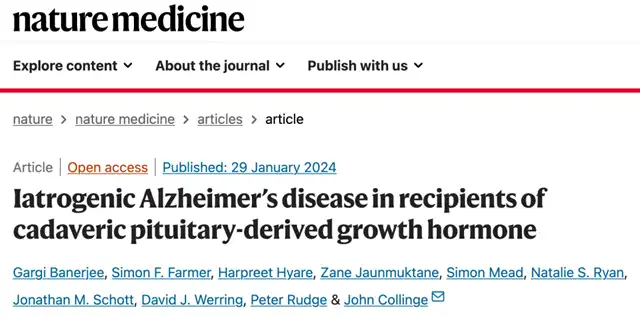Alzheimer’s Disease: Can it be Transmitted Like a Contagious Disease?
- Normal Liver Cells Found to Promote Cancer Metastasis to the Liver
- Nearly 80% Complete Remission: Breakthrough in ADC Anti-Tumor Treatment
- Vaccination Against Common Diseases May Prevent Dementia!
- New Alzheimer’s Disease (AD) Diagnosis and Staging Criteria
- Breakthrough in Alzheimer’s Disease: New Nasal Spray Halts Cognitive Decline by Targeting Toxic Protein
- Can the Tap Water at the Paris Olympics be Drunk Directly?
Alzheimer’s Disease: Can it be Transmitted Like a Contagious Disease?
- Should China be held legally responsible for the US’s $18 trillion COVID losses?
- CT Radiation Exposure Linked to Blood Cancer in Children and Adolescents
- FDA has mandated a top-level black box warning for all marketed CAR-T therapies
- Can people with high blood pressure eat peanuts?
- What is the difference between dopamine and dobutamine?
- How long can the patient live after heart stent surgery?
Alzheimer’s Disease: Can it be Transmitted Like a Contagious Disease? Groundbreaking Discovery Resembles Prion Transmission
In 1957, American scientist Daniel Gajdusek discovered an unusual disease called Kuru among the Fore tribe in Papua New Guinea. The disease had a long incubation period, but those affected would succumb to it within months of onset. Gajdusek found that the disease resulted from a specific Fore tribe practice of consuming the tissues of the deceased during funerals, leading to the spread of an unknown pathogenic factor. Upon Gajdusek’s persuasion, the Fore tribe abandoned this practice, and Kuru disappeared.
Later, it was revealed that the pathogen behind Kuru was the infamous prion, primarily associated with sporadic Creutzfeldt-Jakob disease (CJD) and, in rare cases, genetic prion diseases like fatal familial insomnia. Unlike most prion diseases, acquired prion diseases like Kuru are exceptionally rare. In the 1990s, a new form of acquired prion disease called variant CJD emerged due to the consumption of beef contaminated with bovine spongiform encephalopathy (mad cow disease). There were also isolated cases of prion infections due to medical procedures, such as treatment with human growth hormone extracted from cadaveric pituitary glands.
Recent research indicates that common neurodegenerative diseases in humans, such as Alzheimer’s and Parkinson’s, involve the accumulation and spreading of misfolded proteins, similar to prion diseases.
The discovery of iatrogenic Alzheimer’s disease, published on January 29, 2024, in the journal Nature Medicine by John Collinge’s team at University College London’s Prion Diseases Research Institute, presents the first evidence of Alzheimer’s transmission through medical treatment.

Contrary to traditional viruses, prions, including those causing Alzheimer’s, consist entirely of proteins without any DNA or RNA. Various human prion diseases share a common molecular mechanism involving mutations in the PRNP gene encoding prion protein (PrP), causing the misfolding of PrP from its normal form (PrPC) to the pathogenic form (PrPSc). PrPSc can convert normal PrPC proteins it contacts into the disease-causing PrPSc form, leading to illness and death.
Between 1959 and 1985, at least 1848 individuals in the UK received human growth hormone (c-hGH) extracted from cadaveric pituitary glands. Following cases of individuals developing CJD and dying after receiving prion-contaminated c-hGH, the product was globally recalled and replaced by synthetic growth hormone.
In the brains of some recipients, post-mortem examinations revealed pathological abnormalities associated with beta-amyloid (Aβ), a hallmark of Alzheimer’s. However, it remains unclear if these individuals exhibited Alzheimer’s symptoms before death, potentially overshadowed by their CJD symptoms.
In a study involving eight individuals who received c-hGH in childhood but did not develop CJD, five showed symptoms consistent with early-onset dementia (manifesting between ages 38-55) meeting Alzheimer’s diagnostic criteria. Two others demonstrated mild cognitive impairment, and one had subjective cognitive symptoms, while the third showed no symptoms.
Biomarker analysis was inconclusive for diagnosing the disease in asymptomatic individuals but supported the Alzheimer’s diagnosis in two confirmed cases and suggested signs in another. Autopsies on two deceased participants revealed Alzheimer’s pathology. Genetic testing for genes associated with early-onset Alzheimer’s yielded negative results in five sampled patients.
In summary, all patients in this study shared the common factor of receiving c-hGH treatment derived from cadaveric pituitary glands. Given the compelling evidence of Aβ transmission in batches of c-hGH contaminated with Aβ, the most reasonable explanation is that the clinical syndrome observed in these patients can be termed iatrogenic Alzheimer’s disease.
Therefore, akin to CJD, Alzheimer’s may have different forms, including sporadic, genetic, and iatrogenic. Alzheimer’s should now be considered a potentially transmissible disease.
Considering the higher incidence of Alzheimer’s compared to CJD, the possibility of Aβ contamination in c-hGH extracted from cadaveric pituitary glands is much more significant.
Recognizing the potential for Aβ transmission to cause iatrogenic Alzheimer’s underscores the need for oversight measures to prevent the spread of Alzheimer’s through medical or surgical interventions.
These findings may shed light on processes driving other forms of Alzheimer’s and offer new insights into treatment strategies.
Read the full research paper:
https://www.nature.com/articles/s41591-023-02729-2
https://www.nature.com/articles/s41586-018-0790-y
Alzheimer’s Disease: Can it be Transmitted Like a Contagious Disease?
(source:internet, reference only)
Disclaimer of medicaltrend.org
Important Note: The information provided is for informational purposes only and should not be considered as medical advice.



